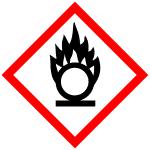Sodium Dichloroisocyanurate

Sodium Dichloroisocyanurate structure
|
Common Name | Sodium Dichloroisocyanurate | ||
|---|---|---|---|---|
| CAS Number | 2893-78-9 | Molecular Weight | 219.946 | |
| Density | 2.06 g/cm3 | Boiling Point | 306.7ºC at 760 mmHg | |
| Molecular Formula | C3Cl2N3NaO3 | Melting Point | 225°C | |
| MSDS | Chinese USA | Flash Point | 139.3ºC | |
| Symbol |




GHS03, GHS05, GHS07, GHS09 |
Signal Word | Danger | |
|
Assessment of the working range and effect of sodium dichloroisocyanurate on Pseudomonas aeruginosa biofilms and planktonic cells.
Biofouling 28(1) , 111-20, (2012) Sodium dichloroisocyanurate (NaDCC) is a chemical agent that acts against microorganisms in a manner similar to that of sodium hypochlorite by releasing free available chlorine. NaDCC has been approved by the WHO for the emergency treatment of water and by th... |
|
|
Effects of pH and oil-in-water emulsions on growth and physicochemical cell surface properties ofListeria monocytogenes: Impact on tolerance to the bactericidal activity of disinfectants
Int. J. Food Microbiol. 130(2) , 101-7, (2009) This study characterizes the effects of an acidic pH and an emulsified oil-in-water phase in a culture medium on the behavior of Listeria monocytogenes. Two strains were tested, Scott A and CIP 78.39, and exhibited similar responses to growth media. First of ... |
|
|
Analytical method for the quantitative determination of cyanuric acid as the degradation product of sodium dichloroisocyanurate in urine by liquid chromatography mass spectrometry.
J. Chromatogr. B. Analyt. Technol. Biomed. Life Sci. 853(1-2) , 360-3, (2007) A simple and selective analytical method for the quantitative determination of cyanuric acid, the degradation product of sodium dichloroisocyanurate (NaDCC), in human urine is reported herein. The sample preparation involved the use of diatomaceous earth extr... |
|
|
Disinfection by-product formation and mitigation strategies in point-of-use chlorination with sodium dichloroisocyanurate in Tanzania.
Am. J. Trop. Med. Hyg. 83(1) , 135-43, (2010) Almost a billion persons lack access to improved drinking water, and diarrheal diseases cause an estimated 1.87 million deaths per year. Sodium dichloroisocyanurate (NaDCC) tablets are widely recommended for household water treatment to reduce diarrhea. Becau... |
|
|
Reactive airways dysfunction syndrome from acute inhalation of a dishwasher detergent powder.
Can. Respir. J. 19(3) , e25-8, (2012) Reactive airway dysfunction syndrome, a type of occupational asthma without a latency period, is induced by irritating vapour, fumes or smoke. The present report is the first to describe a case of reactive airway dysfunction syndrome caused by acute exposure ... |
|
|
Comparative sporicidal effects of disinfectants after release of a biological agent.
Mil. Med. 172(6) , 616-21, (2007) Because of spore formation, Bacillus anthracis is considered the most resistant biological warfare agent known. The present study aimed to assess and compare well-known decontamination routes to inactivate the spores on daily-use environmental tools contamina... |
|
|
Currently available sporicides for use in healthcare, and their limitations.
J. Hosp. Infect. 77(3) , 210-2, (2011) Clostridium difficile has been recognised for some time as a pathogen which can contaminate the environment and which is associated with secondary spread via this route. Unfortunately many of the disinfectants currently used in healthcare environments are ina... |
|
|
The effectiveness of a single-stage versus traditional three-staged protocol of hospital disinfection at eradicating vancomycin-resistant Enterococci from frequently touched surfaces.
Am. J. Infect. Control 41(3) , 227-31, (2013) Environmental contamination is a reservoir for vancomycin-resistant enterococcus (VRE) in hospitals.Environmental sampling of surfaces was undertaken anytime before disinfection and 1 hour after disinfection utilizing a sodium dichloroisocyanurate-based, 3-st... |
|
|
Collection of indonaphthol blue on a membrane filter for the spectrophotometric determination of ammonia with 1-naphthol and dichloroisocyanurate.
Anal. Sci. 26(7) , 779-83, (2010) In order to determine ammonium ion in water samples, we propose a method based on the Berthelot reaction of ammonia with 1-naphthol and dichloroisocyanurate to form an indophenol blue derivative and collection of the blue compound as an ion pair using Zephira... |
|
|
The effectiveness of sodium dichloroisocyanurate treatments against Clostridium difficile spores contaminating stainless steel.
Am. J. Infect. Control 39(3) , 199-205, (2011) Clostridium difficile is a major cause of hospital-associated infective diarrhea, and its spore form can persist for months in the hospital environment. Chlorine-based cleaning agents are recommended for eliminating this reservoir of potential infection.To in... |